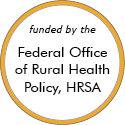Rural Project Examples: Children and youth
Other Project Examples
The Sapling Center
Updated/reviewed June 2025
- Need: To create a safe space for youth and young adults, ages 14 to 25, in rural eastern Kentucky.
- Intervention: The Sapling Center provides independent living skills education and offers a wide array of services as well as fun activities in a supportive environment.
- Results: The 5 Sapling Center locations serve 50-75 teens and young adults every day.
Together We Can Be Bully Free
Updated/reviewed June 2025
- Need: Union Parish, a rural county in Louisiana, continues to experience elevated rates of youth suicide, bullying, mental health challenges, and risk behaviors, as confirmed by a 2024 Community Health Needs Assessment (CHNA).
- Intervention: Union General Hospital, a Critical Access Hospital, started a program to educate students grade 4 through 12 on the negative effects of bullying, to foster positive social behavior, and to provide mental health support through school-based interventions.
- Results: Over 3,500 students have learned how to recognize, report, and respond to bullying. The program's integration with broader community health priorities has strengthened mental health, reduced suicide attempts, and improved awareness of youth risk behaviors.
Project ACTIVATE (Advancing Coordinated and Timely InterVentions, Awareness, Training, and Education)
Updated/reviewed May 2025
- Need: To improve students' access to behavioral health services in rural North Carolina.
- Intervention: North Carolina Project ACTIVATE provides three tiers of behavioral health supports in the school setting.
- Results: The six pilot sites (Cohorts 1 and 2) have created or revised 91 mental health policies, and 48,531 school-based and related employees have received training in different topics and protocols.
Cold Water Safety Children and Youth Educator Program

Updated/reviewed April 2025
- Need: Drowning was a leading cause of death for children in Alaska.
- Intervention: Cold Water Safety and Survival for Educators workshops were developed in 1998, with help from a 4-year federal grant, to train educators to provide education and hands-on skills for school children and members of the public.
- Results: The safety program was integrated into about 79% of Alaskan school curriculum and schools in other states, helping to train hundreds of educators and thousands of children on the importance of cold water safety.
Delta Dental Mobile Program
Updated/reviewed April 2025
- Need: Lack of access to oral healthcare for children from limited-income families in the rural and urban areas of South Dakota.
- Intervention: Delta Dental of South Dakota launched the Delta Dental Mobile Program in 2004 to expand access to oral healthcare services to children throughout the rural state.
- Results: The Delta Dental Mobile Program has provided over $44 million in dental care to more than 73,000 South Dakota children.
Jana's Campaign: Secondary Education Prevention Programming
Updated/reviewed April 2025
- Need: To reduce teen dating violence in middle schools, high schools, and youth organizations by promoting healthy relationship behaviors and fostering a culture of respect among adolescents.
- Intervention: Jana's Campaign offers prevention programs, including curricular and co-curricular activities, to highlight the 'red flags' and underlying causes of unhealthy dating relationships.
- Results: Since 2013, 677 middle and high schools and more than 102,350 students in Kansas, Nebraska, Colorado, Missouri, Oklahoma, Texas, Oregon, Montana, and Washington State have benefited from these programs.
Mother's Milk Bank of South Carolina
Updated/reviewed April 2025
- Need: Neonatal Intensive Care Units (NICUs) across the state of South Carolina were purchasing breast milk from out-of-state milk banks for preterm infants.
- Intervention: The Mother's Milk Bank of South Carolina (MMBSC) opened 25 sites in South Carolina for breast milk to be donated, safely pasteurized, and delivered to NICUs across the state.
- Results: Over 24,320,167 ounces of milk have been donated to MMBSC depot sites and over 14,932,920 ounces of milk have been delivered to South Carolina NICUs.
Tea Time with Teens
Updated/reviewed December 2024
- Need: To develop teen leaders, build self-confidence, and lower teen pregnancy rates in Marlboro County, South Carolina.
- Intervention: Tea Time with Teens brings together community leaders, mothers, and daughters to build life skills and make healthy decisions. In addition, the program sponsors a middle school club and has an extension program for young women.
- Results: Since 2009, the program has been educating teens on making healthy choices and adults on having meaningful conversations with teens.
Butte Child Evaluation Center

Updated/reviewed August 2024
- Need: Before 2000, Butte and southwest Montana saw around 1,300 cases of child abuse a year, with only a 20% conviction rate for perpetrators of sexual abuse.
- Intervention: Multiple agencies in the community came together to address the issue of child abuse by forming the Butte Child Evaluation Center (CEC), a Children's Advocacy Center.
- Results: During a 3-year grant cycle, over 200 interviews and exams were performed on victims of sexual abuse and the Butte CEC became the first program in Montana to be accredited by the National Children's Alliance.
Camp Mariposa
Updated/reviewed August 2024
- Need: To help children whose family members are struggling with substance misuse.
- Intervention: A year-round program provides mentoring as well as substance use prevention education.
- Results: In 2023, Camp Mariposa served a total of 113 youth in its four rural locations in Indiana, Kentucky, Tennessee, and West Virginia. In a study, 92% of participants reported no use of any substance to get high.
For examples from other sources, see:
